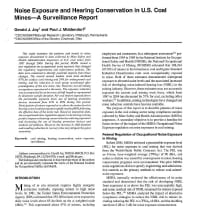Mining Publication: Noise Exposure and Hearing Conservation in US. Coal Mines - A Surveillance Report
Original creation date: January 2007
Authors: GJ Joy, PJ Middendorf
NIOSHTIC2 Number: 20031451
J Occup Environ Hyg 2007 Jan; 4(1); :26-35
This study examines the patterns and trends in noise exposure documented in data collected by Mine Safety and Health Administration inspectors at U.S. coal mines from 1987 through 2004. During this period, MSHA issued a new regulation on occupational noise exposure that changed the regulatory requirements and enforcement policies. The data were examined to identify potential impacts from these changes. The overall annual median noise dose declined 67% for surface coal mining and 24% for underground coal mining, and the reduction in each group accelerated after promulgation of the new noise rule. However, not all mining occupations experienced a decrease. The exposure reduction was accompanied by an increase of shift length as represented by dosimeter sample duration. For coal miners exposed above the permissible exposure level, use of hearing protection devices increased from 61% to 89% during this period. Participation of miners exposed at or above the action level in hearing conservation programs rapidly reached 86% following the effective date of the noise rule. Based on inspection data, the occupational noise regulation appears to be having a strong positive impact on hearing conservation by reducing exposures and increasing the use of hearing protection devices and medical surveillance. However, the increase in shift duration and resulting reduction in recovery time may mitigate the gains somewhat.

NIOSHTIC2 Number: 20031451
J Occup Environ Hyg 2007 Jan; 4(1); :26-35
- Cross-Sectional Survey of Noise Exposure in the Mining Industry
- Determination of Sound Exposures (DOSES): Software Manual and Implementation Guide
- Evaluation and Development of Hearing Loss Interventions
- How Can I Test My Hearing Protection?
- The Modern Evolution of Hearing Conservation Regulations
- NIOSH Hearing Loss Simulator Instruction and Training Guide
- Noise and Hearing Protection: Development of Two Training Exercises for Drillers
- Sound Restoration Hearing Protection: Genesis of a Standard Test Method
- Technology News 536 - NIOSH Develops New Software to Analyze and Reduce Noise Exposure
- Working in Noise with a Hearing Loss: Perceptions from Workers, Supervisors, and Hearing Conservation Program Managers